HRM4002 - Anglian Water Group: Leadership, Teams, and Motivation
VerifiedAdded on 2023/06/03
|10
|2892
|145
Case Study
AI Summary
This case study examines the organizational dynamics of Anglian Water Group, focusing on the interplay between structure, culture, and leadership in driving effective transitional change. It analyzes the roles leadership plays in fostering a change management mentality, managing transitions, and embodying desired changes. The study further explores how organizational structure and culture support these transitions by defining roles, promoting collaboration, and aligning values. The research delves into strategies Anglian Water can employ to build effective teams through motivation, including fair compensation, a positive work environment, opportunities for self-development, and fostering collaboration and happiness. The case highlights the importance of people in achieving organizational goals and the critical role of leadership in navigating change and fostering a motivated workforce. Desklib provides access to similar case studies and resources for students.
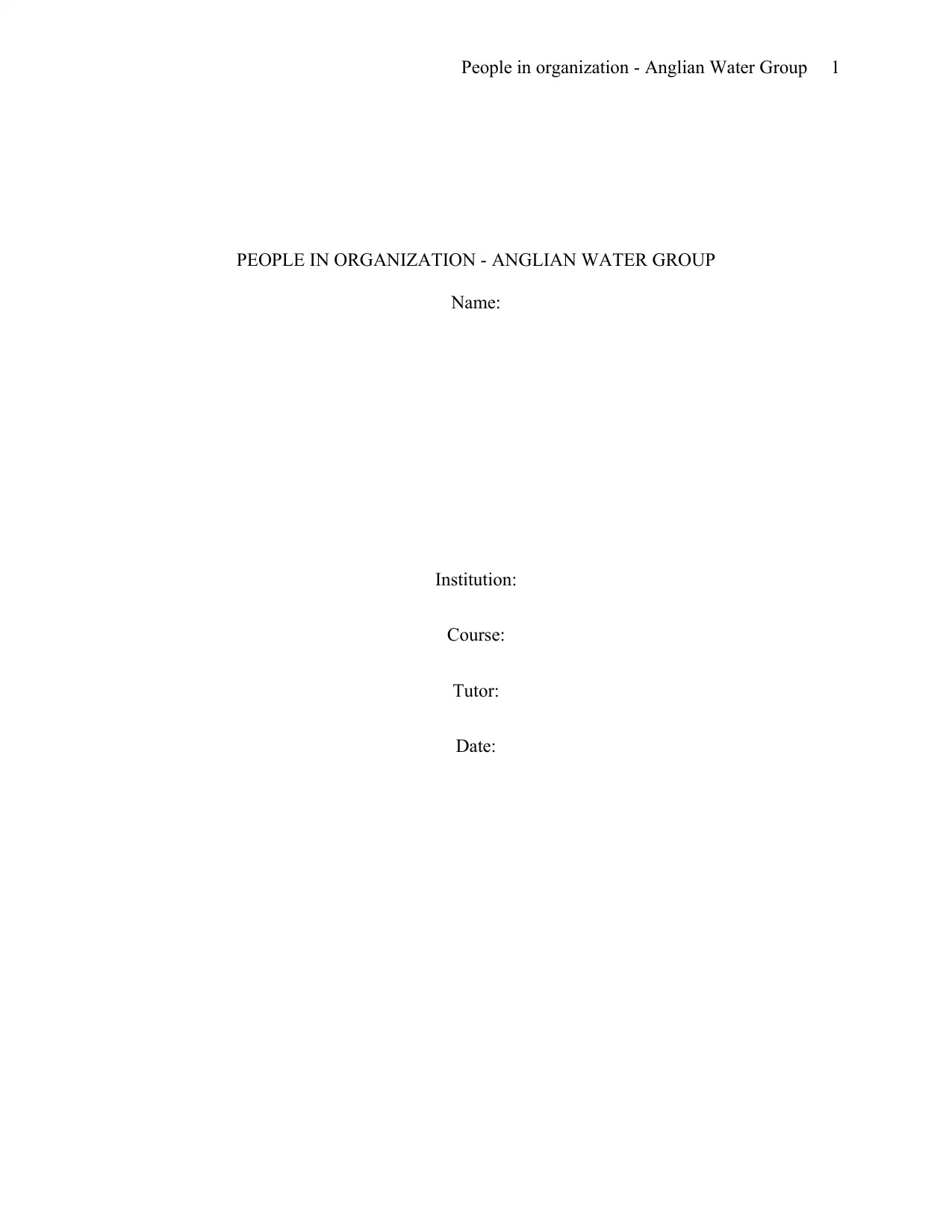
People in organization - Anglian Water Group 1
PEOPLE IN ORGANIZATION - ANGLIAN WATER GROUP
Name:
Institution:
Course:
Tutor:
Date:
PEOPLE IN ORGANIZATION - ANGLIAN WATER GROUP
Name:
Institution:
Course:
Tutor:
Date:
Paraphrase This Document
Need a fresh take? Get an instant paraphrase of this document with our AI Paraphraser
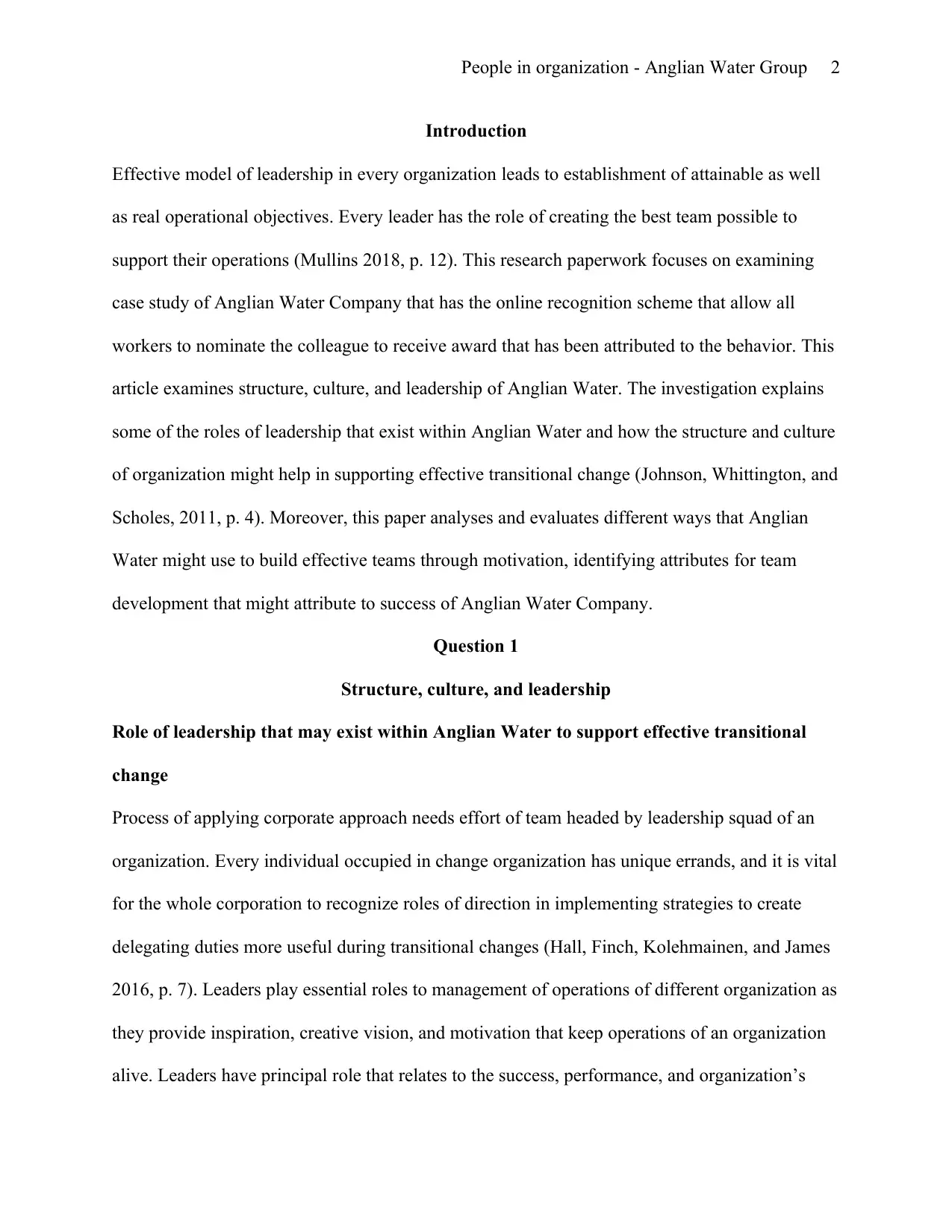
People in organization - Anglian Water Group 2
Introduction
Effective model of leadership in every organization leads to establishment of attainable as well
as real operational objectives. Every leader has the role of creating the best team possible to
support their operations (Mullins 2018, p. 12). This research paperwork focuses on examining
case study of Anglian Water Company that has the online recognition scheme that allow all
workers to nominate the colleague to receive award that has been attributed to the behavior. This
article examines structure, culture, and leadership of Anglian Water. The investigation explains
some of the roles of leadership that exist within Anglian Water and how the structure and culture
of organization might help in supporting effective transitional change (Johnson, Whittington, and
Scholes, 2011, p. 4). Moreover, this paper analyses and evaluates different ways that Anglian
Water might use to build effective teams through motivation, identifying attributes for team
development that might attribute to success of Anglian Water Company.
Question 1
Structure, culture, and leadership
Role of leadership that may exist within Anglian Water to support effective transitional
change
Process of applying corporate approach needs effort of team headed by leadership squad of an
organization. Every individual occupied in change organization has unique errands, and it is vital
for the whole corporation to recognize roles of direction in implementing strategies to create
delegating duties more useful during transitional changes (Hall, Finch, Kolehmainen, and James
2016, p. 7). Leaders play essential roles to management of operations of different organization as
they provide inspiration, creative vision, and motivation that keep operations of an organization
alive. Leaders have principal role that relates to the success, performance, and organization’s
Introduction
Effective model of leadership in every organization leads to establishment of attainable as well
as real operational objectives. Every leader has the role of creating the best team possible to
support their operations (Mullins 2018, p. 12). This research paperwork focuses on examining
case study of Anglian Water Company that has the online recognition scheme that allow all
workers to nominate the colleague to receive award that has been attributed to the behavior. This
article examines structure, culture, and leadership of Anglian Water. The investigation explains
some of the roles of leadership that exist within Anglian Water and how the structure and culture
of organization might help in supporting effective transitional change (Johnson, Whittington, and
Scholes, 2011, p. 4). Moreover, this paper analyses and evaluates different ways that Anglian
Water might use to build effective teams through motivation, identifying attributes for team
development that might attribute to success of Anglian Water Company.
Question 1
Structure, culture, and leadership
Role of leadership that may exist within Anglian Water to support effective transitional
change
Process of applying corporate approach needs effort of team headed by leadership squad of an
organization. Every individual occupied in change organization has unique errands, and it is vital
for the whole corporation to recognize roles of direction in implementing strategies to create
delegating duties more useful during transitional changes (Hall, Finch, Kolehmainen, and James
2016, p. 7). Leaders play essential roles to management of operations of different organization as
they provide inspiration, creative vision, and motivation that keep operations of an organization
alive. Leaders have principal role that relates to the success, performance, and organization’s
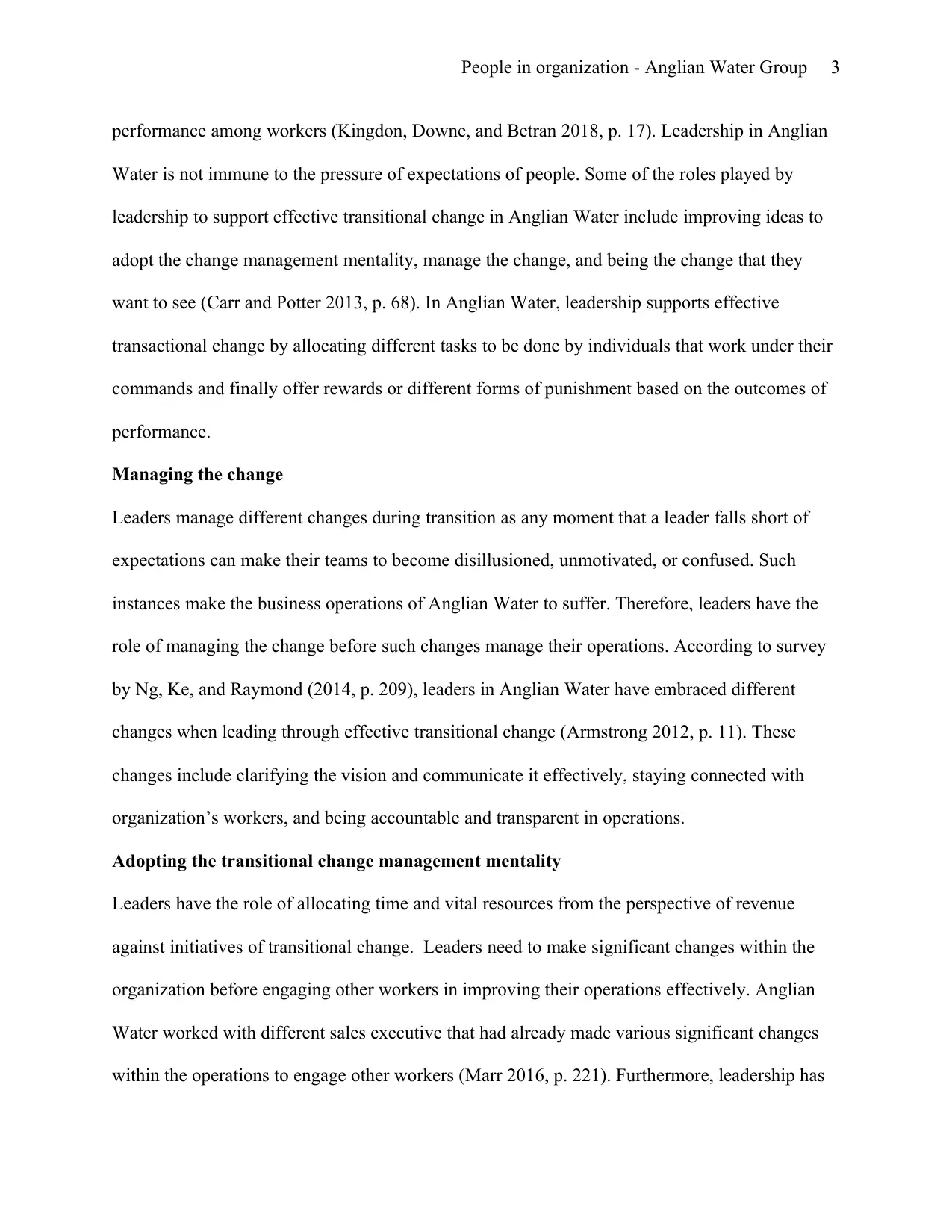
People in organization - Anglian Water Group 3
performance among workers (Kingdon, Downe, and Betran 2018, p. 17). Leadership in Anglian
Water is not immune to the pressure of expectations of people. Some of the roles played by
leadership to support effective transitional change in Anglian Water include improving ideas to
adopt the change management mentality, manage the change, and being the change that they
want to see (Carr and Potter 2013, p. 68). In Anglian Water, leadership supports effective
transactional change by allocating different tasks to be done by individuals that work under their
commands and finally offer rewards or different forms of punishment based on the outcomes of
performance.
Managing the change
Leaders manage different changes during transition as any moment that a leader falls short of
expectations can make their teams to become disillusioned, unmotivated, or confused. Such
instances make the business operations of Anglian Water to suffer. Therefore, leaders have the
role of managing the change before such changes manage their operations. According to survey
by Ng, Ke, and Raymond (2014, p. 209), leaders in Anglian Water have embraced different
changes when leading through effective transitional change (Armstrong 2012, p. 11). These
changes include clarifying the vision and communicate it effectively, staying connected with
organization’s workers, and being accountable and transparent in operations.
Adopting the transitional change management mentality
Leaders have the role of allocating time and vital resources from the perspective of revenue
against initiatives of transitional change. Leaders need to make significant changes within the
organization before engaging other workers in improving their operations effectively. Anglian
Water worked with different sales executive that had already made various significant changes
within the operations to engage other workers (Marr 2016, p. 221). Furthermore, leadership has
performance among workers (Kingdon, Downe, and Betran 2018, p. 17). Leadership in Anglian
Water is not immune to the pressure of expectations of people. Some of the roles played by
leadership to support effective transitional change in Anglian Water include improving ideas to
adopt the change management mentality, manage the change, and being the change that they
want to see (Carr and Potter 2013, p. 68). In Anglian Water, leadership supports effective
transactional change by allocating different tasks to be done by individuals that work under their
commands and finally offer rewards or different forms of punishment based on the outcomes of
performance.
Managing the change
Leaders manage different changes during transition as any moment that a leader falls short of
expectations can make their teams to become disillusioned, unmotivated, or confused. Such
instances make the business operations of Anglian Water to suffer. Therefore, leaders have the
role of managing the change before such changes manage their operations. According to survey
by Ng, Ke, and Raymond (2014, p. 209), leaders in Anglian Water have embraced different
changes when leading through effective transitional change (Armstrong 2012, p. 11). These
changes include clarifying the vision and communicate it effectively, staying connected with
organization’s workers, and being accountable and transparent in operations.
Adopting the transitional change management mentality
Leaders have the role of allocating time and vital resources from the perspective of revenue
against initiatives of transitional change. Leaders need to make significant changes within the
organization before engaging other workers in improving their operations effectively. Anglian
Water worked with different sales executive that had already made various significant changes
within the operations to engage other workers (Marr 2016, p. 221). Furthermore, leadership has
⊘ This is a preview!⊘
Do you want full access?
Subscribe today to unlock all pages.

Trusted by 1+ million students worldwide
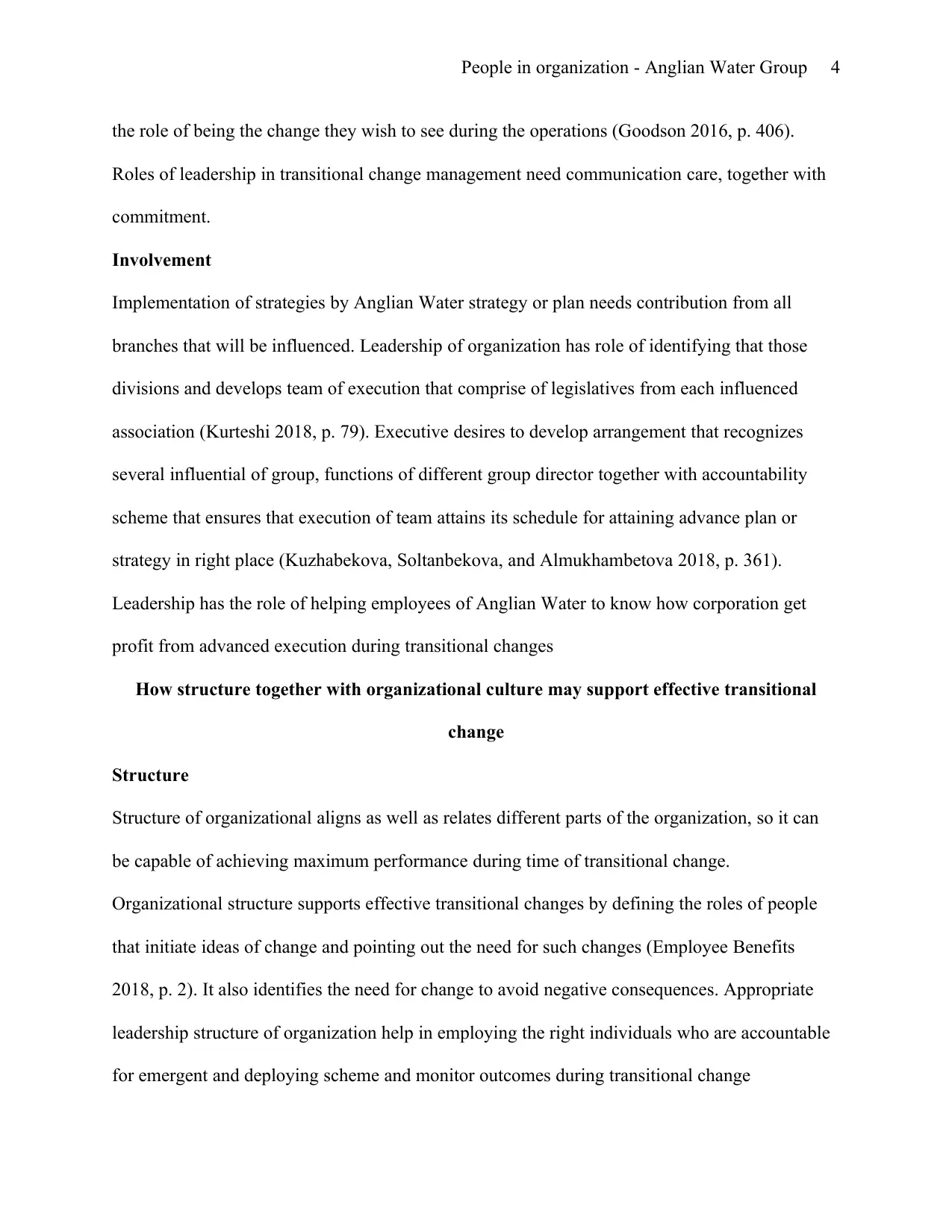
People in organization - Anglian Water Group 4
the role of being the change they wish to see during the operations (Goodson 2016, p. 406).
Roles of leadership in transitional change management need communication care, together with
commitment.
Involvement
Implementation of strategies by Anglian Water strategy or plan needs contribution from all
branches that will be influenced. Leadership of organization has role of identifying that those
divisions and develops team of execution that comprise of legislatives from each influenced
association (Kurteshi 2018, p. 79). Executive desires to develop arrangement that recognizes
several influential of group, functions of different group director together with accountability
scheme that ensures that execution of team attains its schedule for attaining advance plan or
strategy in right place (Kuzhabekova, Soltanbekova, and Almukhambetova 2018, p. 361).
Leadership has the role of helping employees of Anglian Water to know how corporation get
profit from advanced execution during transitional changes
How structure together with organizational culture may support effective transitional
change
Structure
Structure of organizational aligns as well as relates different parts of the organization, so it can
be capable of achieving maximum performance during time of transitional change.
Organizational structure supports effective transitional changes by defining the roles of people
that initiate ideas of change and pointing out the need for such changes (Employee Benefits
2018, p. 2). It also identifies the need for change to avoid negative consequences. Appropriate
leadership structure of organization help in employing the right individuals who are accountable
for emergent and deploying scheme and monitor outcomes during transitional change
the role of being the change they wish to see during the operations (Goodson 2016, p. 406).
Roles of leadership in transitional change management need communication care, together with
commitment.
Involvement
Implementation of strategies by Anglian Water strategy or plan needs contribution from all
branches that will be influenced. Leadership of organization has role of identifying that those
divisions and develops team of execution that comprise of legislatives from each influenced
association (Kurteshi 2018, p. 79). Executive desires to develop arrangement that recognizes
several influential of group, functions of different group director together with accountability
scheme that ensures that execution of team attains its schedule for attaining advance plan or
strategy in right place (Kuzhabekova, Soltanbekova, and Almukhambetova 2018, p. 361).
Leadership has the role of helping employees of Anglian Water to know how corporation get
profit from advanced execution during transitional changes
How structure together with organizational culture may support effective transitional
change
Structure
Structure of organizational aligns as well as relates different parts of the organization, so it can
be capable of achieving maximum performance during time of transitional change.
Organizational structure supports effective transitional changes by defining the roles of people
that initiate ideas of change and pointing out the need for such changes (Employee Benefits
2018, p. 2). It also identifies the need for change to avoid negative consequences. Appropriate
leadership structure of organization help in employing the right individuals who are accountable
for emergent and deploying scheme and monitor outcomes during transitional change
Paraphrase This Document
Need a fresh take? Get an instant paraphrase of this document with our AI Paraphraser
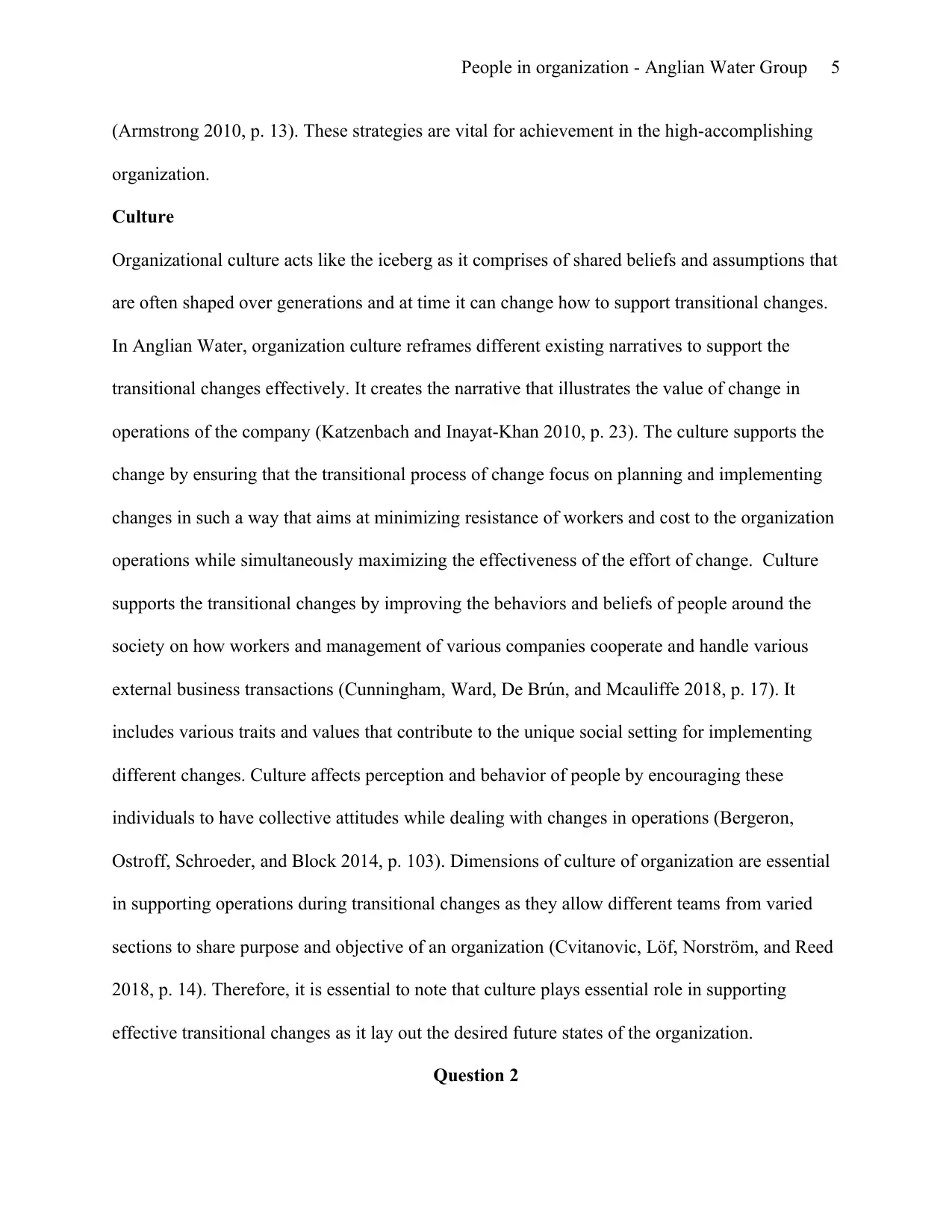
People in organization - Anglian Water Group 5
(Armstrong 2010, p. 13). These strategies are vital for achievement in the high-accomplishing
organization.
Culture
Organizational culture acts like the iceberg as it comprises of shared beliefs and assumptions that
are often shaped over generations and at time it can change how to support transitional changes.
In Anglian Water, organization culture reframes different existing narratives to support the
transitional changes effectively. It creates the narrative that illustrates the value of change in
operations of the company (Katzenbach and Inayat-Khan 2010, p. 23). The culture supports the
change by ensuring that the transitional process of change focus on planning and implementing
changes in such a way that aims at minimizing resistance of workers and cost to the organization
operations while simultaneously maximizing the effectiveness of the effort of change. Culture
supports the transitional changes by improving the behaviors and beliefs of people around the
society on how workers and management of various companies cooperate and handle various
external business transactions (Cunningham, Ward, De Brún, and Mcauliffe 2018, p. 17). It
includes various traits and values that contribute to the unique social setting for implementing
different changes. Culture affects perception and behavior of people by encouraging these
individuals to have collective attitudes while dealing with changes in operations (Bergeron,
Ostroff, Schroeder, and Block 2014, p. 103). Dimensions of culture of organization are essential
in supporting operations during transitional changes as they allow different teams from varied
sections to share purpose and objective of an organization (Cvitanovic, Löf, Norström, and Reed
2018, p. 14). Therefore, it is essential to note that culture plays essential role in supporting
effective transitional changes as it lay out the desired future states of the organization.
Question 2
(Armstrong 2010, p. 13). These strategies are vital for achievement in the high-accomplishing
organization.
Culture
Organizational culture acts like the iceberg as it comprises of shared beliefs and assumptions that
are often shaped over generations and at time it can change how to support transitional changes.
In Anglian Water, organization culture reframes different existing narratives to support the
transitional changes effectively. It creates the narrative that illustrates the value of change in
operations of the company (Katzenbach and Inayat-Khan 2010, p. 23). The culture supports the
change by ensuring that the transitional process of change focus on planning and implementing
changes in such a way that aims at minimizing resistance of workers and cost to the organization
operations while simultaneously maximizing the effectiveness of the effort of change. Culture
supports the transitional changes by improving the behaviors and beliefs of people around the
society on how workers and management of various companies cooperate and handle various
external business transactions (Cunningham, Ward, De Brún, and Mcauliffe 2018, p. 17). It
includes various traits and values that contribute to the unique social setting for implementing
different changes. Culture affects perception and behavior of people by encouraging these
individuals to have collective attitudes while dealing with changes in operations (Bergeron,
Ostroff, Schroeder, and Block 2014, p. 103). Dimensions of culture of organization are essential
in supporting operations during transitional changes as they allow different teams from varied
sections to share purpose and objective of an organization (Cvitanovic, Löf, Norström, and Reed
2018, p. 14). Therefore, it is essential to note that culture plays essential role in supporting
effective transitional changes as it lay out the desired future states of the organization.
Question 2
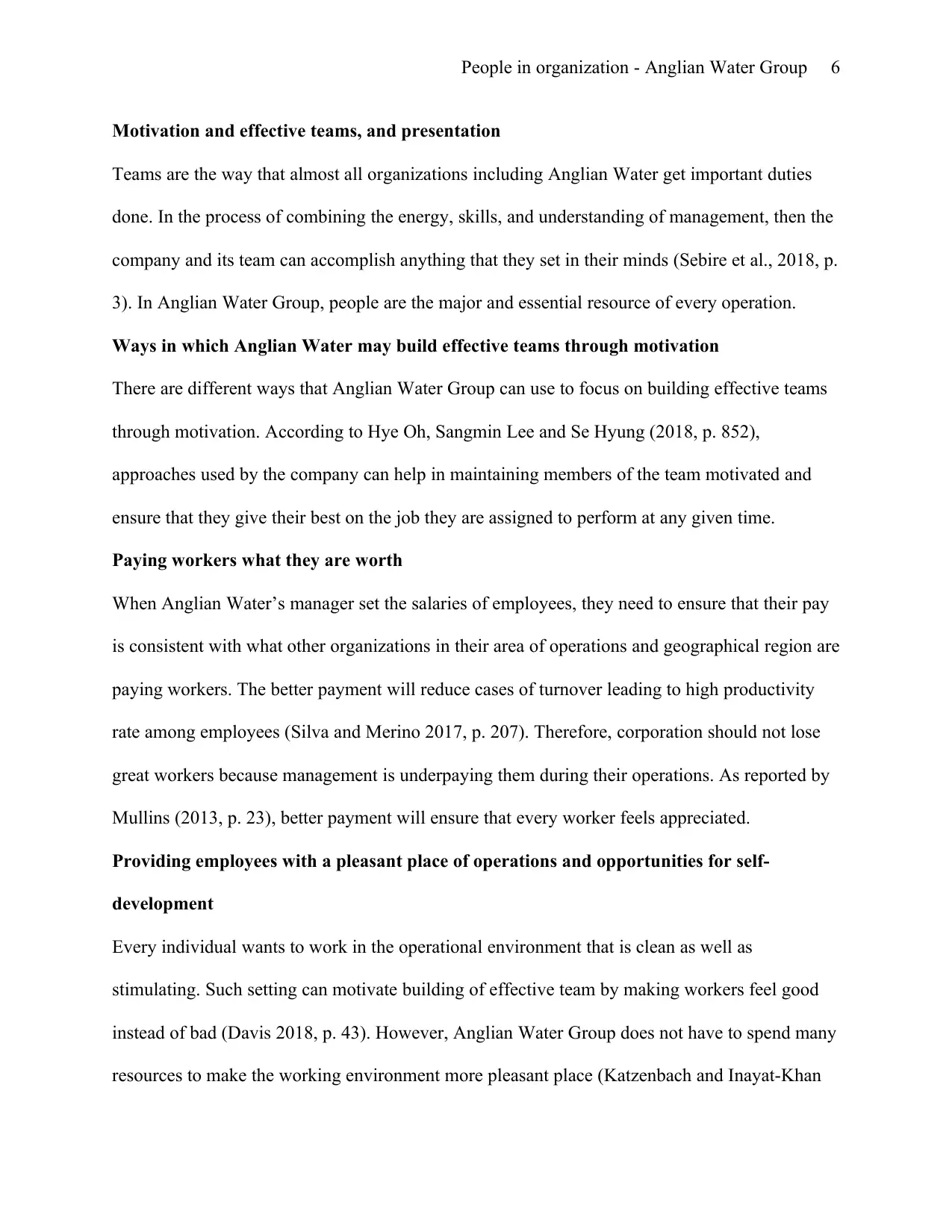
People in organization - Anglian Water Group 6
Motivation and effective teams, and presentation
Teams are the way that almost all organizations including Anglian Water get important duties
done. In the process of combining the energy, skills, and understanding of management, then the
company and its team can accomplish anything that they set in their minds (Sebire et al., 2018, p.
3). In Anglian Water Group, people are the major and essential resource of every operation.
Ways in which Anglian Water may build effective teams through motivation
There are different ways that Anglian Water Group can use to focus on building effective teams
through motivation. According to Hye Oh, Sangmin Lee and Se Hyung (2018, p. 852),
approaches used by the company can help in maintaining members of the team motivated and
ensure that they give their best on the job they are assigned to perform at any given time.
Paying workers what they are worth
When Anglian Water’s manager set the salaries of employees, they need to ensure that their pay
is consistent with what other organizations in their area of operations and geographical region are
paying workers. The better payment will reduce cases of turnover leading to high productivity
rate among employees (Silva and Merino 2017, p. 207). Therefore, corporation should not lose
great workers because management is underpaying them during their operations. As reported by
Mullins (2013, p. 23), better payment will ensure that every worker feels appreciated.
Providing employees with a pleasant place of operations and opportunities for self-
development
Every individual wants to work in the operational environment that is clean as well as
stimulating. Such setting can motivate building of effective team by making workers feel good
instead of bad (Davis 2018, p. 43). However, Anglian Water Group does not have to spend many
resources to make the working environment more pleasant place (Katzenbach and Inayat-Khan
Motivation and effective teams, and presentation
Teams are the way that almost all organizations including Anglian Water get important duties
done. In the process of combining the energy, skills, and understanding of management, then the
company and its team can accomplish anything that they set in their minds (Sebire et al., 2018, p.
3). In Anglian Water Group, people are the major and essential resource of every operation.
Ways in which Anglian Water may build effective teams through motivation
There are different ways that Anglian Water Group can use to focus on building effective teams
through motivation. According to Hye Oh, Sangmin Lee and Se Hyung (2018, p. 852),
approaches used by the company can help in maintaining members of the team motivated and
ensure that they give their best on the job they are assigned to perform at any given time.
Paying workers what they are worth
When Anglian Water’s manager set the salaries of employees, they need to ensure that their pay
is consistent with what other organizations in their area of operations and geographical region are
paying workers. The better payment will reduce cases of turnover leading to high productivity
rate among employees (Silva and Merino 2017, p. 207). Therefore, corporation should not lose
great workers because management is underpaying them during their operations. As reported by
Mullins (2013, p. 23), better payment will ensure that every worker feels appreciated.
Providing employees with a pleasant place of operations and opportunities for self-
development
Every individual wants to work in the operational environment that is clean as well as
stimulating. Such setting can motivate building of effective team by making workers feel good
instead of bad (Davis 2018, p. 43). However, Anglian Water Group does not have to spend many
resources to make the working environment more pleasant place (Katzenbach and Inayat-Khan
⊘ This is a preview!⊘
Do you want full access?
Subscribe today to unlock all pages.

Trusted by 1+ million students worldwide
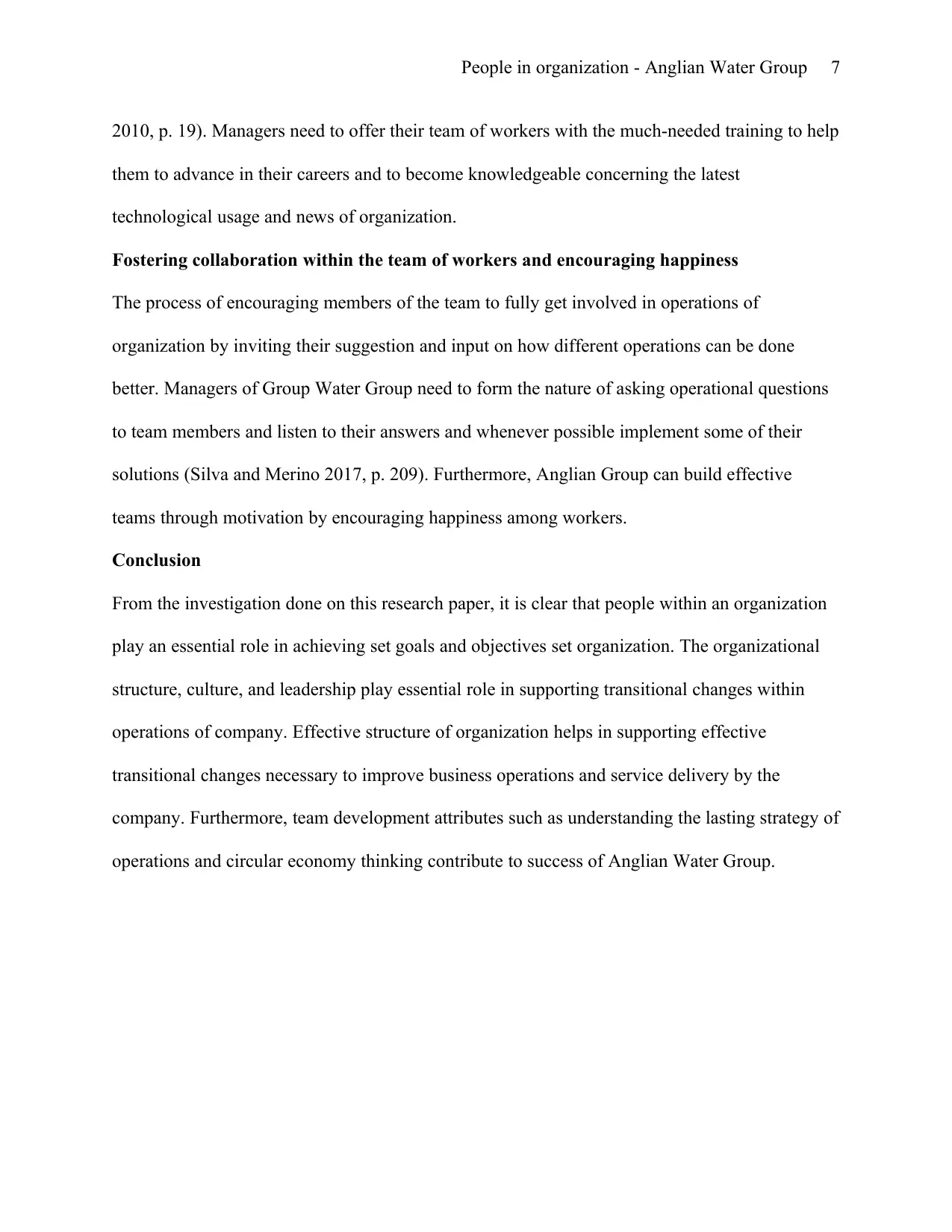
People in organization - Anglian Water Group 7
2010, p. 19). Managers need to offer their team of workers with the much-needed training to help
them to advance in their careers and to become knowledgeable concerning the latest
technological usage and news of organization.
Fostering collaboration within the team of workers and encouraging happiness
The process of encouraging members of the team to fully get involved in operations of
organization by inviting their suggestion and input on how different operations can be done
better. Managers of Group Water Group need to form the nature of asking operational questions
to team members and listen to their answers and whenever possible implement some of their
solutions (Silva and Merino 2017, p. 209). Furthermore, Anglian Group can build effective
teams through motivation by encouraging happiness among workers.
Conclusion
From the investigation done on this research paper, it is clear that people within an organization
play an essential role in achieving set goals and objectives set organization. The organizational
structure, culture, and leadership play essential role in supporting transitional changes within
operations of company. Effective structure of organization helps in supporting effective
transitional changes necessary to improve business operations and service delivery by the
company. Furthermore, team development attributes such as understanding the lasting strategy of
operations and circular economy thinking contribute to success of Anglian Water Group.
2010, p. 19). Managers need to offer their team of workers with the much-needed training to help
them to advance in their careers and to become knowledgeable concerning the latest
technological usage and news of organization.
Fostering collaboration within the team of workers and encouraging happiness
The process of encouraging members of the team to fully get involved in operations of
organization by inviting their suggestion and input on how different operations can be done
better. Managers of Group Water Group need to form the nature of asking operational questions
to team members and listen to their answers and whenever possible implement some of their
solutions (Silva and Merino 2017, p. 209). Furthermore, Anglian Group can build effective
teams through motivation by encouraging happiness among workers.
Conclusion
From the investigation done on this research paper, it is clear that people within an organization
play an essential role in achieving set goals and objectives set organization. The organizational
structure, culture, and leadership play essential role in supporting transitional changes within
operations of company. Effective structure of organization helps in supporting effective
transitional changes necessary to improve business operations and service delivery by the
company. Furthermore, team development attributes such as understanding the lasting strategy of
operations and circular economy thinking contribute to success of Anglian Water Group.
Paraphrase This Document
Need a fresh take? Get an instant paraphrase of this document with our AI Paraphraser
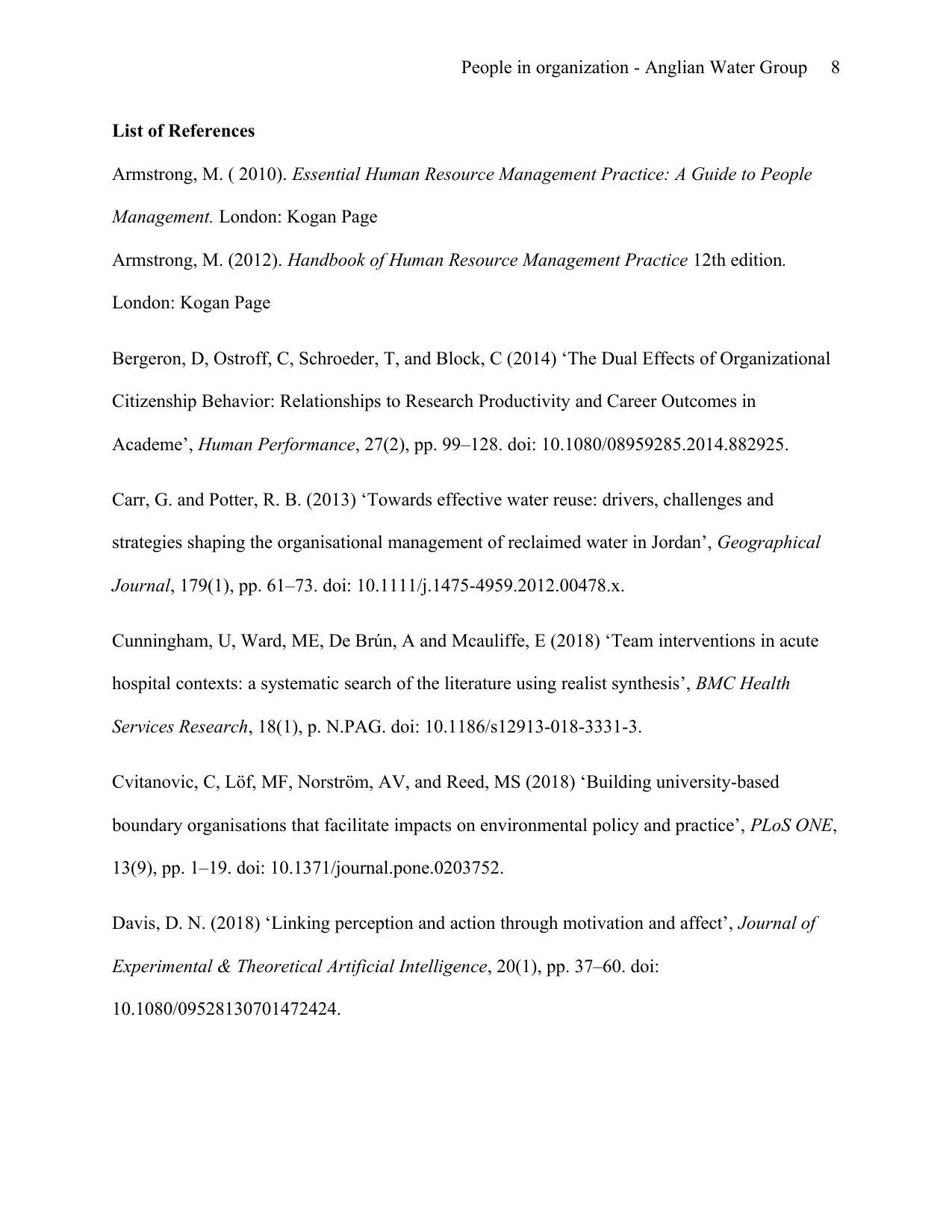
People in organization - Anglian Water Group 8
List of References
Armstrong, M. ( 2010). Essential Human Resource Management Practice: A Guide to People
Management. London: Kogan Page
Armstrong, M. (2012). Handbook of Human Resource Management Practice 12th edition.
London: Kogan Page
Bergeron, D, Ostroff, C, Schroeder, T, and Block, C (2014) ‘The Dual Effects of Organizational
Citizenship Behavior: Relationships to Research Productivity and Career Outcomes in
Academe’, Human Performance, 27(2), pp. 99–128. doi: 10.1080/08959285.2014.882925.
Carr, G. and Potter, R. B. (2013) ‘Towards effective water reuse: drivers, challenges and
strategies shaping the organisational management of reclaimed water in Jordan’, Geographical
Journal, 179(1), pp. 61–73. doi: 10.1111/j.1475-4959.2012.00478.x.
Cunningham, U, Ward, ME, De Brún, A and Mcauliffe, E (2018) ‘Team interventions in acute
hospital contexts: a systematic search of the literature using realist synthesis’, BMC Health
Services Research, 18(1), p. N.PAG. doi: 10.1186/s12913-018-3331-3.
Cvitanovic, C, Löf, MF, Norström, AV, and Reed, MS (2018) ‘Building university-based
boundary organisations that facilitate impacts on environmental policy and practice’, PLoS ONE,
13(9), pp. 1–19. doi: 10.1371/journal.pone.0203752.
Davis, D. N. (2018) ‘Linking perception and action through motivation and affect’, Journal of
Experimental & Theoretical Artificial Intelligence, 20(1), pp. 37–60. doi:
10.1080/09528130701472424.
List of References
Armstrong, M. ( 2010). Essential Human Resource Management Practice: A Guide to People
Management. London: Kogan Page
Armstrong, M. (2012). Handbook of Human Resource Management Practice 12th edition.
London: Kogan Page
Bergeron, D, Ostroff, C, Schroeder, T, and Block, C (2014) ‘The Dual Effects of Organizational
Citizenship Behavior: Relationships to Research Productivity and Career Outcomes in
Academe’, Human Performance, 27(2), pp. 99–128. doi: 10.1080/08959285.2014.882925.
Carr, G. and Potter, R. B. (2013) ‘Towards effective water reuse: drivers, challenges and
strategies shaping the organisational management of reclaimed water in Jordan’, Geographical
Journal, 179(1), pp. 61–73. doi: 10.1111/j.1475-4959.2012.00478.x.
Cunningham, U, Ward, ME, De Brún, A and Mcauliffe, E (2018) ‘Team interventions in acute
hospital contexts: a systematic search of the literature using realist synthesis’, BMC Health
Services Research, 18(1), p. N.PAG. doi: 10.1186/s12913-018-3331-3.
Cvitanovic, C, Löf, MF, Norström, AV, and Reed, MS (2018) ‘Building university-based
boundary organisations that facilitate impacts on environmental policy and practice’, PLoS ONE,
13(9), pp. 1–19. doi: 10.1371/journal.pone.0203752.
Davis, D. N. (2018) ‘Linking perception and action through motivation and affect’, Journal of
Experimental & Theoretical Artificial Intelligence, 20(1), pp. 37–60. doi:
10.1080/09528130701472424.
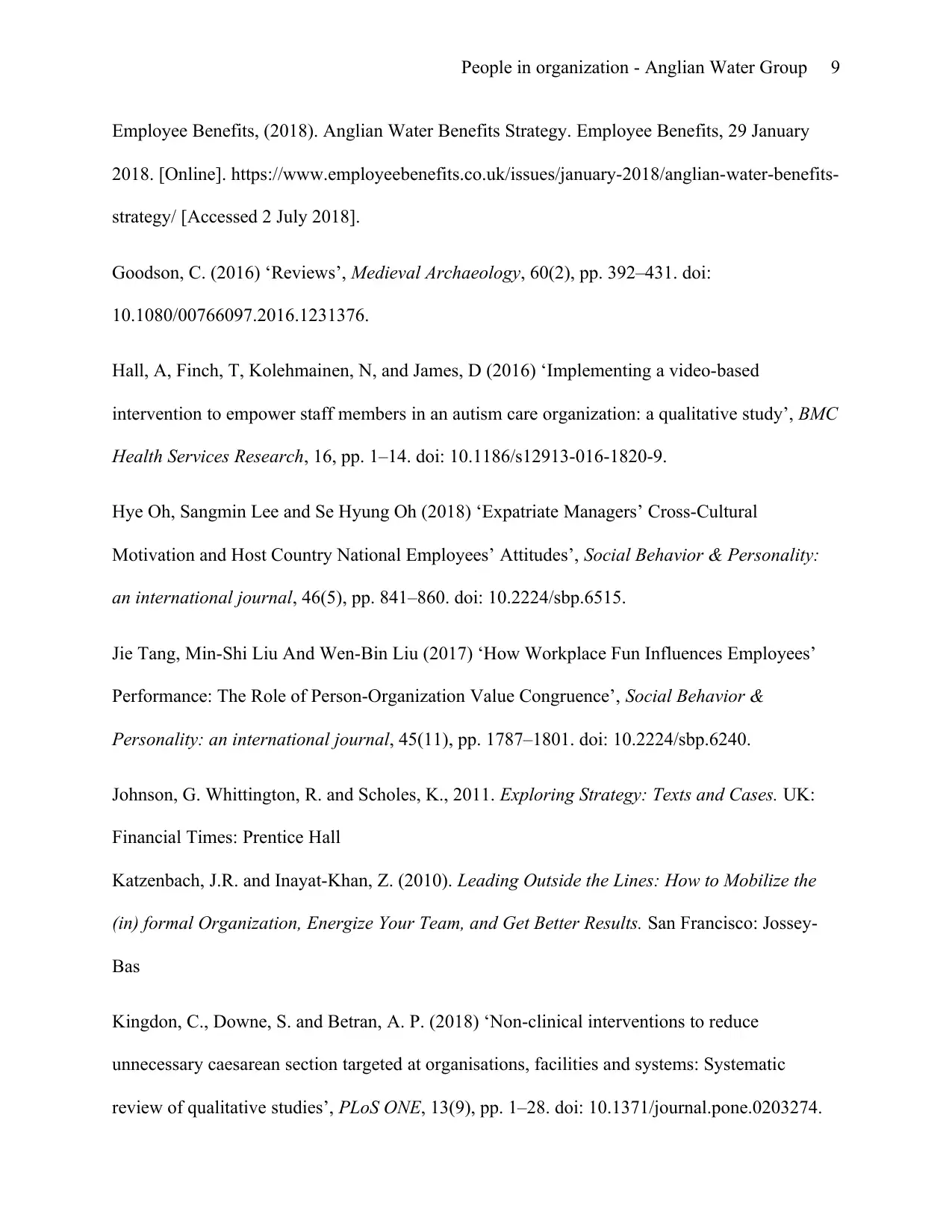
People in organization - Anglian Water Group 9
Employee Benefits, (2018). Anglian Water Benefits Strategy. Employee Benefits, 29 January
2018. [Online]. https://www.employeebenefits.co.uk/issues/january-2018/anglian-water-benefits-
strategy/ [Accessed 2 July 2018].
Goodson, C. (2016) ‘Reviews’, Medieval Archaeology, 60(2), pp. 392–431. doi:
10.1080/00766097.2016.1231376.
Hall, A, Finch, T, Kolehmainen, N, and James, D (2016) ‘Implementing a video-based
intervention to empower staff members in an autism care organization: a qualitative study’, BMC
Health Services Research, 16, pp. 1–14. doi: 10.1186/s12913-016-1820-9.
Hye Oh, Sangmin Lee and Se Hyung Oh (2018) ‘Expatriate Managers’ Cross-Cultural
Motivation and Host Country National Employees’ Attitudes’, Social Behavior & Personality:
an international journal, 46(5), pp. 841–860. doi: 10.2224/sbp.6515.
Jie Tang, Min-Shi Liu And Wen-Bin Liu (2017) ‘How Workplace Fun Influences Employees’
Performance: The Role of Person-Organization Value Congruence’, Social Behavior &
Personality: an international journal, 45(11), pp. 1787–1801. doi: 10.2224/sbp.6240.
Johnson, G. Whittington, R. and Scholes, K., 2011. Exploring Strategy: Texts and Cases. UK:
Financial Times: Prentice Hall
Katzenbach, J.R. and Inayat-Khan, Z. (2010). Leading Outside the Lines: How to Mobilize the
(in) formal Organization, Energize Your Team, and Get Better Results. San Francisco: Jossey-
Bas
Kingdon, C., Downe, S. and Betran, A. P. (2018) ‘Non-clinical interventions to reduce
unnecessary caesarean section targeted at organisations, facilities and systems: Systematic
review of qualitative studies’, PLoS ONE, 13(9), pp. 1–28. doi: 10.1371/journal.pone.0203274.
Employee Benefits, (2018). Anglian Water Benefits Strategy. Employee Benefits, 29 January
2018. [Online]. https://www.employeebenefits.co.uk/issues/january-2018/anglian-water-benefits-
strategy/ [Accessed 2 July 2018].
Goodson, C. (2016) ‘Reviews’, Medieval Archaeology, 60(2), pp. 392–431. doi:
10.1080/00766097.2016.1231376.
Hall, A, Finch, T, Kolehmainen, N, and James, D (2016) ‘Implementing a video-based
intervention to empower staff members in an autism care organization: a qualitative study’, BMC
Health Services Research, 16, pp. 1–14. doi: 10.1186/s12913-016-1820-9.
Hye Oh, Sangmin Lee and Se Hyung Oh (2018) ‘Expatriate Managers’ Cross-Cultural
Motivation and Host Country National Employees’ Attitudes’, Social Behavior & Personality:
an international journal, 46(5), pp. 841–860. doi: 10.2224/sbp.6515.
Jie Tang, Min-Shi Liu And Wen-Bin Liu (2017) ‘How Workplace Fun Influences Employees’
Performance: The Role of Person-Organization Value Congruence’, Social Behavior &
Personality: an international journal, 45(11), pp. 1787–1801. doi: 10.2224/sbp.6240.
Johnson, G. Whittington, R. and Scholes, K., 2011. Exploring Strategy: Texts and Cases. UK:
Financial Times: Prentice Hall
Katzenbach, J.R. and Inayat-Khan, Z. (2010). Leading Outside the Lines: How to Mobilize the
(in) formal Organization, Energize Your Team, and Get Better Results. San Francisco: Jossey-
Bas
Kingdon, C., Downe, S. and Betran, A. P. (2018) ‘Non-clinical interventions to reduce
unnecessary caesarean section targeted at organisations, facilities and systems: Systematic
review of qualitative studies’, PLoS ONE, 13(9), pp. 1–28. doi: 10.1371/journal.pone.0203274.
⊘ This is a preview!⊘
Do you want full access?
Subscribe today to unlock all pages.

Trusted by 1+ million students worldwide
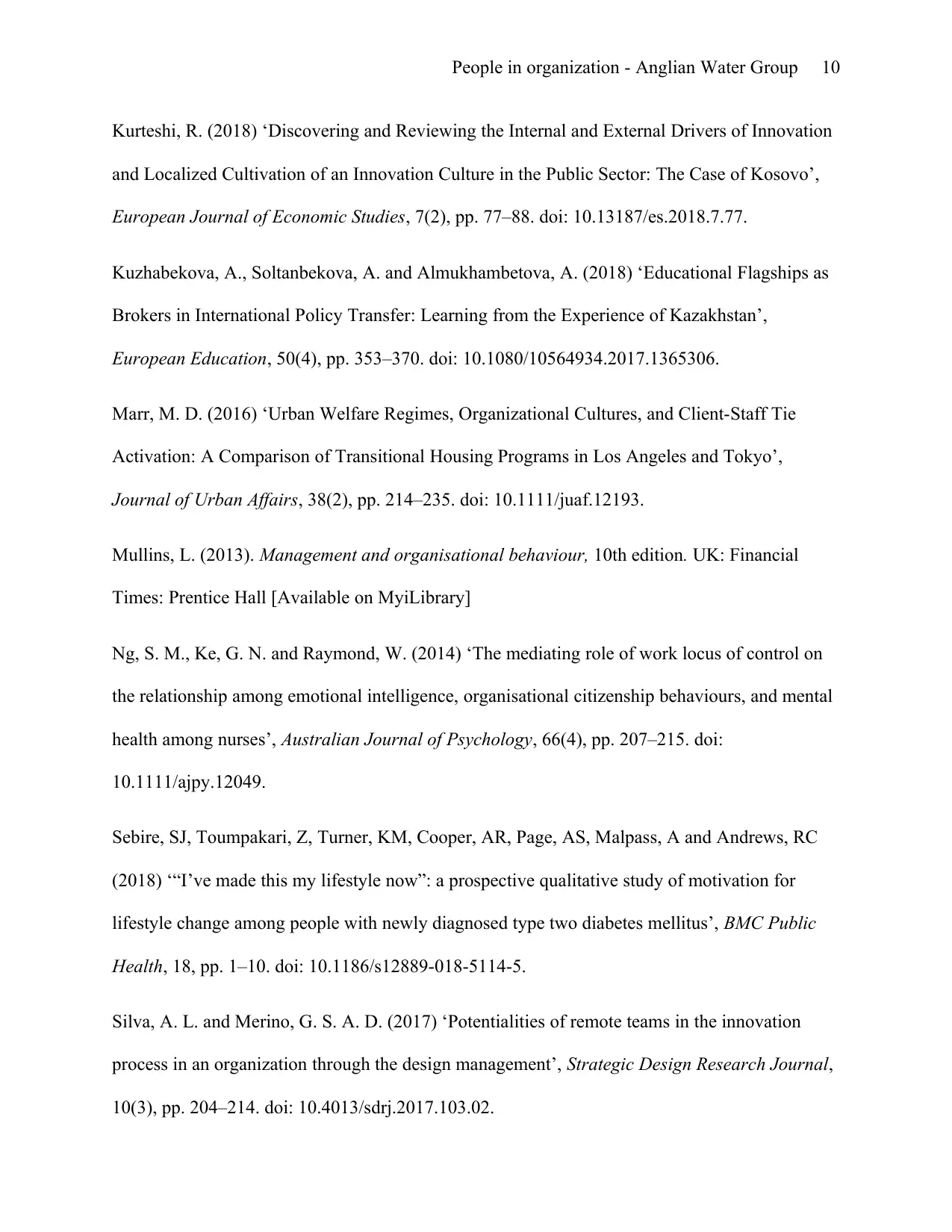
People in organization - Anglian Water Group 10
Kurteshi, R. (2018) ‘Discovering and Reviewing the Internal and External Drivers of Innovation
and Localized Cultivation of an Innovation Culture in the Public Sector: The Case of Kosovo’,
European Journal of Economic Studies, 7(2), pp. 77–88. doi: 10.13187/es.2018.7.77.
Kuzhabekova, A., Soltanbekova, A. and Almukhambetova, A. (2018) ‘Educational Flagships as
Brokers in International Policy Transfer: Learning from the Experience of Kazakhstan’,
European Education, 50(4), pp. 353–370. doi: 10.1080/10564934.2017.1365306.
Marr, M. D. (2016) ‘Urban Welfare Regimes, Organizational Cultures, and Client-Staff Tie
Activation: A Comparison of Transitional Housing Programs in Los Angeles and Tokyo’,
Journal of Urban Affairs, 38(2), pp. 214–235. doi: 10.1111/juaf.12193.
Mullins, L. (2013). Management and organisational behaviour, 10th edition. UK: Financial
Times: Prentice Hall [Available on MyiLibrary]
Ng, S. M., Ke, G. N. and Raymond, W. (2014) ‘The mediating role of work locus of control on
the relationship among emotional intelligence, organisational citizenship behaviours, and mental
health among nurses’, Australian Journal of Psychology, 66(4), pp. 207–215. doi:
10.1111/ajpy.12049.
Sebire, SJ, Toumpakari, Z, Turner, KM, Cooper, AR, Page, AS, Malpass, A and Andrews, RC
(2018) ‘“I’ve made this my lifestyle now”: a prospective qualitative study of motivation for
lifestyle change among people with newly diagnosed type two diabetes mellitus’, BMC Public
Health, 18, pp. 1–10. doi: 10.1186/s12889-018-5114-5.
Silva, A. L. and Merino, G. S. A. D. (2017) ‘Potentialities of remote teams in the innovation
process in an organization through the design management’, Strategic Design Research Journal,
10(3), pp. 204–214. doi: 10.4013/sdrj.2017.103.02.
Kurteshi, R. (2018) ‘Discovering and Reviewing the Internal and External Drivers of Innovation
and Localized Cultivation of an Innovation Culture in the Public Sector: The Case of Kosovo’,
European Journal of Economic Studies, 7(2), pp. 77–88. doi: 10.13187/es.2018.7.77.
Kuzhabekova, A., Soltanbekova, A. and Almukhambetova, A. (2018) ‘Educational Flagships as
Brokers in International Policy Transfer: Learning from the Experience of Kazakhstan’,
European Education, 50(4), pp. 353–370. doi: 10.1080/10564934.2017.1365306.
Marr, M. D. (2016) ‘Urban Welfare Regimes, Organizational Cultures, and Client-Staff Tie
Activation: A Comparison of Transitional Housing Programs in Los Angeles and Tokyo’,
Journal of Urban Affairs, 38(2), pp. 214–235. doi: 10.1111/juaf.12193.
Mullins, L. (2013). Management and organisational behaviour, 10th edition. UK: Financial
Times: Prentice Hall [Available on MyiLibrary]
Ng, S. M., Ke, G. N. and Raymond, W. (2014) ‘The mediating role of work locus of control on
the relationship among emotional intelligence, organisational citizenship behaviours, and mental
health among nurses’, Australian Journal of Psychology, 66(4), pp. 207–215. doi:
10.1111/ajpy.12049.
Sebire, SJ, Toumpakari, Z, Turner, KM, Cooper, AR, Page, AS, Malpass, A and Andrews, RC
(2018) ‘“I’ve made this my lifestyle now”: a prospective qualitative study of motivation for
lifestyle change among people with newly diagnosed type two diabetes mellitus’, BMC Public
Health, 18, pp. 1–10. doi: 10.1186/s12889-018-5114-5.
Silva, A. L. and Merino, G. S. A. D. (2017) ‘Potentialities of remote teams in the innovation
process in an organization through the design management’, Strategic Design Research Journal,
10(3), pp. 204–214. doi: 10.4013/sdrj.2017.103.02.
1 out of 10
Related Documents
Your All-in-One AI-Powered Toolkit for Academic Success.
+13062052269
info@desklib.com
Available 24*7 on WhatsApp / Email
![[object Object]](/_next/static/media/star-bottom.7253800d.svg)
Unlock your academic potential
Copyright © 2020–2025 A2Z Services. All Rights Reserved. Developed and managed by ZUCOL.





